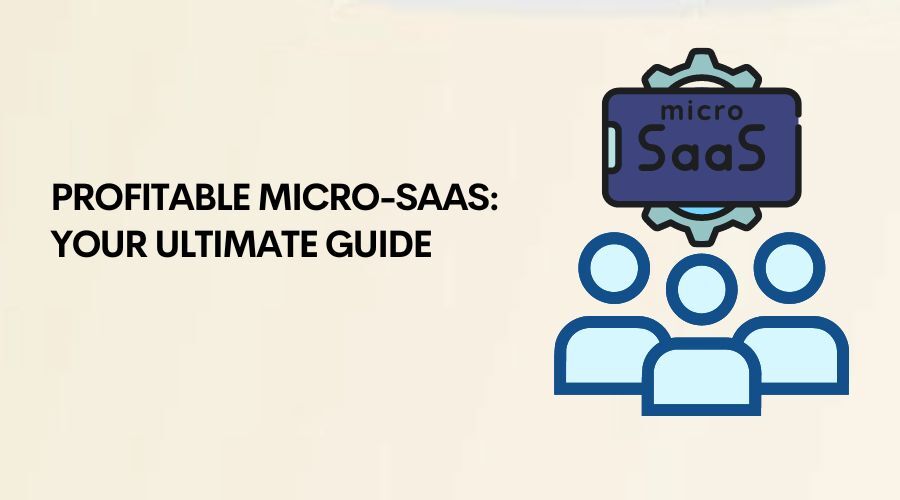Welcome to the world of micro-SaaS.
If you’ve ever found yourself wishing there was a product that can help you—and probably a select few others—solve a very minor problem, you’re in the right place.
Let’s walk you bit by bit through what we mean.
What Is Micro-SaaS?
The word “SaaS” in “micro-SaaS” stands for “Software as a Service”.
In the past, buying software meant always having to pay a one-time fee for every year’s release of its newer versions.
Today, however, SaaS gives you a way to continuously get access to the software’s most updated version as long as you continuously pay on a monthly or annual basis.
That’s how SaaS works.
As for micro-SaaS, it takes the traditional SaaS approach to focus on resolving a very basic need of a dedicated user base rather than a large market.
It uses a few resources and doesn’t get external capital.
Also, only one person or a very small team is usually behind its development.
It’s actually because of this that the word “solo SaaS” (i.e., solo founders of their own software business) came to life.
Who Can Build Micro-SaaS Products?
Trust me when we say anybody can build a micro-SaaS tool.
The only requirement is that you have a particular problem to solve for a particular niche.
Like all business endeavors, it’s not going to be easy to be a micro-SaaS entrepreneur.
But it’s not immensely hard either.
As long as having an independent lifestyle is what you want in life, you can start your own micro-SaaS company even if you take things slow.
In fact, as we’ll discuss later, there are plenty of micro-SaaS founders who were able to take their businesses to the next level while working on their full-time jobs.
Clearly, you only need to want it bad enough to continue seeing it through.
How to Find Micro-SaaS Software Ideas
The good news about business ideas for micro-SaaS is that you can literally find them on your own.
In fact, the concept of micro-SaaS is usually discussed along with the name of Tyler Tringas, who popularized it after creating his Storemapper extension.
And given how micro-SaaS businesses have taken off since then, you can definitely develop your own micro-SaaS software as well.
If you’re not sure where to start, we found some trends you can jump into and ideas you can try.
For example, we enumerated the top micro-SaaS trends to watch out for this year, which include Artificial Intelligence, Machine Learning, and no-code tools.
As for micro-SaaS ideas, examples include eCommerce analytic tools, workforce management, and Learning Management Software (LMS).
These ideas are great starting points because of the value they provide to their users.
They help small business owners automate their processes, improve their decision-making, and even personalize customer and employee interactions.
On the other hand, if these ideas are not something you’re down for, here are a few ways to come up with your own:
1. Look at growing platforms and marketplaces

Remember that micro-SaaS products are small, autonomous software that address a super specific need for users of an already-existing application, software, or program.
Therefore, a good way to find an idea for micro-SaaS is to pick a marketplace where customers are checking out solutions to a particular issue that an existing app doesn’t solve.
2. Observe repeated requests from clients you work with
If you already have existing clients, you can also start there.
In fact, they’re one of the best references you can have since working with them means you’ll get a treasure trove of information for possible micro-SaaS ideas.
3. List down repeatable problems you yourself have with the apps or software you use

As a micro-SaaS entrepreneur, you’ll want to sell solutions that you yourself would want to buy.
And what better way to start than by scratching your itch?
Once you’ve enumerated these problems and determined that solving them will make your life easier, you can then ask around if there are other people facing the same problem as you and looking for a solution.
4. Connect with other micro-SaaS founders
Today’s digital era has made it easier for everyone around the world to form connections, regardless of their geographic location.
So if you want to come up with your own micro-SaaS, another way is to join discussion forums and subscribe to social media communities specifically for people in the micro-SaaS industry.
How Do I Know if I Should Pursue My Micro-SaaS Software Idea?
If you already have an idea in mind for a micro-SaaS and are wondering if it’s a great one to pursue, below are some things you have to consider:
1. A specific niche with a growing size

Just like any other business, a micro-SaaS company has to know the ins and outs of the specific niche it wants to serve.
Otherwise, if you can’t define who your target users are, you would be marketing to and attracting no one.
And if that’s the case, it’ll be very difficult to know what problems to solve if you don’t know who you want to help.
Aside from that, you also have to make sure that the niche you’re serving isn’t saturated or stagnating.
After all, the last thing you’ll want as an entrepreneur is to build a business you can’t sustain just because you’re serving a micro-SaaS niche that can’t grow with you.
2. Potential for revenue
Are the people you want to target spending money to resolve this problem?
If not yet, would they be willing to pay for a solution?
Pieter Levels, founder of Nomad List, mentioned it best when he said you should look for a PURE problem:
- P – Painful so that your customers will see the solution you will provide as something that’s valuable to them
- U – Urgent so that they won’t want to miss out on your solution and instead will take action quickly
- R – Recognized as a problem by the customers you want to serve
- E – Easy to solve using your expertise
This way, even if your target audience doesn’t have the size of a billion-dollar market, you can rest assured that your solution resonates with their problems.
Don’t forget also to consider what the average amount is that your potential customers would willingly spend.
This will help you reverse engineer your success and ensure that you will hit your lifestyle goals.
3. The complexity of your product

Another reason why you have to focus on a niche is that you need to know what type of solution aligns with their tech knowledge.
The less tech-savvy they are, the simpler your micro-SaaS software needs to be.
Not only that, but you’ll want to create a micro-SaaS that is realistically achievable for you as a solopreneur.
If it’s easy to develop even with your limited resources, then go for it.
How to Build Sustainable Micro-SaaS Tools
1. Build your Minimum Viable Product (MVP).
Begin developing your MVP as soon as possible so you can verify the need for your product in the real world.
And if you have no experience with software development, good news: it doesn’t have to be difficult.
There are now a lot of platforms that can help you build micro-SaaS software even when you know nothing about tech.
For instance, AppGyver, Open as App, Clappia, and Jotform are just some of the tools that let you build apps without a single line of code.
2. Gather user feedback and evaluate your product

Collect information on your early adopters to validate your product.
Doing so will help you confirm three important things:
- The problem you’re setting out to tackle is real.
- You’re providing a solution they genuinely need.
- There are enough people who need your micro-SaaS solution.
Verifying all these means you likely have a viable enough business in your hands.
3. Keep your product simple and straightforward by including only the essential features
Be sure to maintain client satisfaction by ensuring that your product solves the issue better than your competitors do.
One way to go about this is by offering exceptional customer service and being attentive to your users’ requirements.
How to Grow a Micro-SaaS Into a Business With Profitable Monthly Recurring Revenue (MRR)
Now that you’ve validated your idea with the first working version of your product, what you’ll likely want next is to grow it into a profitable micro-SaaS.
Here’s what you can do to that end:
1. Concentrate on obtaining your first paying clients

Get your first paying customers by determining the most appropriate marketing strategy for your audience.
For instance, you can let your network know about your new micro-SaaS tool and ask if someone would be willing to try it or if they have referrals they can send your way.
You can also offer product trials or adopt a freemium strategy.
Other methods include attracting your potential customers’ attention through community management, search engine marketing (SEM), and search engine optimization (SEO) tactics.
Once you’ve established a stable client base, you can then concentrate on extending your SaaS company by increasing your product offerings, automating your procedures, or investing in retention strategies.
Make sure to steer clear of common micro-SaaS marketing mistakes, such as ignoring user experience issues, as they can hinder your potential for growth.
2. Encourage fast user adoption
More than acquiring clients, you also need to see to it that your new customers can understand and use your product right away.
Otherwise, a low user adoption rate may mean the death of your product.
Which makes sense, by the way.
After all, when new users struggle to comprehend and utilize your product, they may feel dissatisfied with your service and abandon it much faster than you can blink.
And since paying customers are walking billboards of your brand, any negative feedback they may express to the public may deter prospective clients as well from using your software.
In the long run, this makes the cost of getting new users much higher than it takes to retain one.
Eventually, it won’t be long before you can say goodbye to your micro-SaaS start-up.
3. Adopt the right pricing strategy

One way to grow your idea to the next level is to adopt the right pricing strategy.
What works for you should be something that makes sense for your niche.
However, the most common pricing models include the following:
- Per-user pricing, where customers pay per user;
- Flat pricing, where customers pay a fixed price for access to all your product’s features;
- Tiered pricing, where customers pay only for the usage, features, or quantity they need; and
- Usage-based pricing, where customers pay only when they use a certain feature or service you offer.
What if I Don’t Want to Build My Own Micro-SaaS Start-up?
The thing about the micro-SaaS industry is that it’s so flexible, you can segment micro-SaaS entrepreneurs into different categories.
In fact, at Symalite Labs, we cater to these types of audiences:
- First-time micro-SaaS founders (i.e., individuals with a “big idea” for micro-SaaS but don’t know where to start)
- Individuals who have earned a living in the past as software developer employees and now want to build something for themselves
- Serial entrepreneurs (i.e., business owners who already started, scaled, and sold at least one micro-SaaS company in the past but want to develop another)
- C-level executives of existing businesses in other industries whose CEO wants their team to venture into micro-SaaS
That’s not to say that this is an exclusive list, but these are the main audiences we work with.
And if you find yourself on the other side of the coin, such that you’d much rather acquire an already-existing micro-SaaS company than start from scratch, that’s all well and good too.
Micro-SaaS marketplaces are your new best friend for that.
These digital bazaars provide a convenient way for entrepreneurs and startup communities to acquire and grow existing micro-SaaS businesses.
At the same time, they allow founders to exit safely and monetize their investments.
Some of the marketplaces you can trust for finding vetted micro-SaaS companies include AcquireBase, Empire Flippers, and Acquire.com.
Each platform offers unique features, such as an auction-based system for buying and selling businesses and a range of tools to help buyers and sellers navigate the process.
Factors to Consider When Selecting a Micro-SaaS Company With Value Proposition
Considering the technological advancements today, it’s easy to get lost in the sea of options you have for micro-SaaS products.
But before you can even think of purchasing a micro-SaaS company, we highly suggest that you take a look at the following elements to pick the best option:
- Is there a lot of interest in the product? Conducting market research is essential in establishing its profitability and whether or not there is a validated demand.
- How does the product stack up against competitors in the market? Are there any distinguishing qualities or benefits? Understanding the competitive environment is critical for ensuring the product’s positioning.
- How helpful and responsive is the customer service team? It’s critical to have access to a dedicated customer care staff that can assist with any problems or inquiries.
- Who are the designers? What are their industry experience and track record? A competent staff with industry knowledge can provide assurance that the product will be well-built and well-maintained.
- What are the product’s future plans? A comprehensive product roadmap may give insight into how the product’s development will progress and what new features will be included in the future.
By taking these aspects into account, you can make an educated choice about which micro-SaaS solution is the most excellent match for your requirements and objectives.
How to Buy a Micro-SaaS Company

Once you’ve accounted for all of these factors, here are the steps you can take for acquiring a micro-SaaS company:
- Browse the listings on your preferred marketplace and compile a list of possible leads.
- Check the firm’s legal status and verify that it is in good standing with the tax authorities.
- Examine the company’s financials to confirm that it is a solid investment.
- Assess the company’s marketing value and development possibilities.
- Negotiate the purchase terms and conditions with its founders.
- Once you finalize the purchase, plan your relaunch and integration into the new firm.
- Create a future exit strategy in case you decide to sell the firm or combine it with another venture.
By following these steps and considering all the facts, you can make a well-informed decision and maximize your chances of success.
How to Sell Your Micro-SaaS Startups

Seeing as we’ve given you your guide to buying micro-SaaS, we might as well tackle how you can sell your micro-SaaS start-up:
- List your micro-SaaS company as “for sale” on online marketplaces.
- Collect all your financial reports to give prospective buyers a full view of your micro-SaaS company’s risks and potential profitability.
- Do your due diligence in dealing with interested buyers. As the one selling their business, you have to ensure that your buyer has the necessary financial and business capabilities.
- Finalize the purchase and transfer ownership.
How to Manage Your Micro-SaaS Company
Once you have your own micro-SaaS firm to run, it’s crucial that you learn to manage it efficiently and effectively.
Fortunately, there are different ways you can manage your micro-SaaS company.
1. Start by automating your onboarding and human resource processes
Doing this will expedite the process of hiring and training new workers as well as maintain employee information.
At the same time, it minimizes administrative duties and increases productivity.
2. Maintain an updated inventory of all software you subscribe to and automate your product adoption
Keeping an up-to-date inventory of all business applications and programs you use will help you keep track of what apps you have and which ones you need or are underused.
This way, you can reduce wasteful spending and enhance overall productivity.
Final Thoughts on Building Micro-SaaS Companies in 2023
We hope the information we collected and shared above has enlightened you about what it means to be part of the micro-SaaS industry.
Reading all these resources on micro-SaaS may sound exhausting.
However, these micro-SaaS success stories prove that if others can do it, you can too.
The journey comes with its fair share of challenges, but as long as you’re willing to face them, the rewards are limitless.
Feel free to tap us here at Symalite Labs if you need any help with your micro-SaaS marketing and development!
In the meantime, here are some of the Chrome extensions we’ve worked on.
We’re most especially known for our Group Leads extension, as it helps you convert Facebook group members into paying customers.
Here’s a video showing how you can properly use Group Leads to send welcome messages and tag new members in a welcome post:

